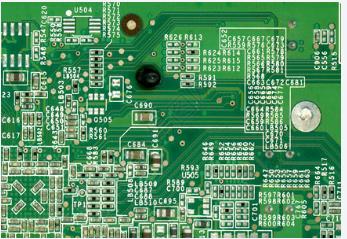1. The hot-air solder is smooth
HASL is the main lead surface treatment process used in the industry. The process is formed by immersing the circuit board in a lead-tin alloy, and the excess solder is removed by an "air knife". The so-called air knife is hot air blowing on the surface of the board. For the PCA process, HASL has many advantages: it is the cheapestPCB, and the surface layer can be soldered after multiple reflow soldering, cleaning and storage. For ICT, HASL also provides a process for automatically covering test pads and vias with solder. However, compared with the existing alternative methods, the flatness or coplanarity of the HASL surface is poor. Now there are some lead-free HASL alternative processes, which are becoming more and more popular due to the natural replacement characteristics of HASL. For many years, HASL has been applied with good results, but with the emergence of "environmental protection" green process requirements, the existence of this process is numbered. In addition to the lead-free problem, increasing board complexity and finer pitch have exposed many limitations of the HASL process.
Advantages: The lowest cost PCB surface process, maintains solderability throughout the manufacturing process, and has no negative impact on ICT.
Disadvantages: Usually lead-containing processes are used. Lead-containing processes are now restricted and will eventually be eliminated by 2007. For fine pin pitch (<0.64mm), it may cause solder bridging and thickness problems. The uneven surface can cause coplanarity problems in the assembly process.
2. Organic solder protective agent
Organic Solder Protector (OSP) is used to produce a thin, uniform protective layer on the copper surface of the PCB. This coating protects the circuit from oxidation during storage and assembly operations. This process has been around for a long time, but only recently has it gained popularity as lead-free technology and fine-pitch solutions are sought.
In terms of coplanarity and solderability, OSP has better performance in PCA assembly than HASL, but requires significant process changes to the type of flux and the number of thermal cycles. Because of its acidic characteristics will reduce OSP performance and make copper easy to oxidize, so careful handling is required. Assemblers prefer to treat metal surfaces that are more flexible and can withstand more thermal cycles.

Using OSP surface treatment, if the test point is not welded, it will cause contact problems with the needle bed fixture in the ICT. Merely changing to a sharper probe type to penetrate the OSP layer will only cause damage and puncture the PCA test via or test pad. Studies have shown that switching to a higher detection force or changing the probe type has little effect on yield. Untreated copper has an order of magnitude higher yield strength than leaded solder, and the only result is that it will damage the exposed copper test pad. All testability guidelines strongly recommend not to directly probe exposed copper. When using OSP, it is necessary to define a set of OSP rules for the ICT phase. The most important rule requires that the Stencil be opened at the beginning of the PCB process to allow solder paste to be applied to the test pads and vias that need to be contacted by the ICT.
Advantages: Comparable with HASL in unit cost, good coplanarity, lead-free process, and improved solderability.
Disadvantages: The assembly process needs to undergo major changes. If the unprocessed copper surface is detected, it will be detrimental to ICT. Over-pointed ICT probes may damage the PCB, requiring manual precautions, limiting ICT testing and reducing test repeatability.
3. Electroless nickel-gold immersion
Electroless nickel-gold immersion (ENIG) coating has been successfully applied on many circuit boards. Although it has a higher unit cost, it has a flat surface and excellent solderability. The main disadvantage is that the electroless nickel layer is very fragile and has been found to be broken under mechanical pressure. This is called "black block" or "mud crack" in the industry, which has led to some negative reports from ENIG.
Advantages: good solderability, flat surface, long storage life, can withstand multiple reflow soldering.
Disadvantages: high cost (about 5 times that of HASL), "black block" problem, manufacturing process using cyanide and other harmful chemicals.
4. Silver Immersion
Silver immersion is a newly added method of PCB surface treatment. It is mainly used in Asia and is being promoted in North America and Europe.
During the soldering process, the silver layer melts into the solder joints, leaving a tin/lead/silver alloy on the copper layer. This alloy provides a very reliable solder joint for BGA packages. Its contrasting color makes it easy to be inspected, and it is also a natural alternative to HASL in welding.
Silver immersion is a surface processing technology with very promising development prospects, but like all new surface processing technologies, end users are very conservative. Many manufacturers regard this process as a "under investigation" process, but it is likely to become the best lead-free surface process choice.
Advantages: good weldability, smooth surface, natural replacement of HASL immersion.
Disadvantages: The conservative attitude of end users means that there is a lack of relevant information in the industry.
5. Tin immersion
This is a relatively new surface treatment process, which has many similar characteristics to the silver immersion process. However, due to the need to prevent thiourea (which may be a carcinogen) used in the tin immersion process in the PCB board manufacturing process, there are major health and safety issues that need to be considered. In addition, attention should be paid to tin migration ("tin burr" effect), although anti-migration chemicals can achieve a certain effect in controlling this problem.
Advantages: good weldability, smooth surface, relatively low cost.
Disadvantages: health and safety issues, limited number of thermal cycles.